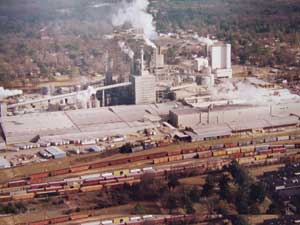Workers Available, Ethanol Producers Wanted




December 9, 2009
BY Kris Bevill
Morehouse Parish and the city of Bastrop, La., suffered a devastating economic loss in November 2008 when International Paper announced it would permanently close the pulp mill it had operated there for more than 80 years. The company's decision was not a surprise to the community. It's been no secret that the paper industry has been lagging in recent years and a weak market and oversupply of product proved to be too much to keep the plant profitable. But for the 12,988 people who live in Bastrop, and particularly the 550 skilled laborers who were employed at the facility, lost jobs meant that commuting or moving out of the area was almost certainly their ultimate fate. Parish leaders, determined to keep a mass exodus to other communities from happening, teamed with state officials to launch economic recovery efforts. It wasn't long before it became apparent that biofuels could be their solution.
"It was a huge blow to the city to lose the plant," says Kelsey Short, director of agriculture, food and forestry for Lousiana's economic development agency. "It was probably one of our biggest economic development blows, particularly because it happened in a small community. The irony about Bastrop was that IP indicated that it was really a very productive, hard-working workforce. It was just that the plant had not been kept up because of a lack of reinvestment capital."
As the state economic development office representative, Short set out to meet with Morehouse Economic Development Corp. members to work on finding a replacement for the IP facility. The first item on the state's do-to list was to provide funds to hire recovery planning experts. Mandeville, La.-based Taimerica Management Co. was chosen for the job and was tasked with identifying target replacement industries for the area. Short said it was obvious early on that bioenergy was a good fit to replace the hole that had been made locally by the shutdown of the paper mill. "If you look around the country, there have been other instances where paper mills have been redeveloped into some type of bioenergy assets," he says.
Workforce Availability
One of the major reasons for this easy transition from the paper industry to the biofuels industry is workforce adaptability. Taimerica reported in its recovery strategy for Bastrop that the pulp and paper industry has an unusually large concentration of blue-collar skilled trades, including industrial maintenance mechanics, stationary engineers and electricians. These skill sets fit closely with those in the metal fabrication, food processing and chemical processing industries—which includes ethanol and biodiesel production.
Kay King, president and CEO of the MEDC, says most of the skilled workers who held jobs at the IP mill are still in the area. "We know that the more time goes by [since the mill's closing], some of the workforce will begin to filter out of the area," she says. "So, we'd like to capture another company into the area before we lose that workforce." According to King, approximately 30 percent of the former IP workers are commuting to jobs at other paper mills in the area.
Short says Taimerica identified the parish's workforce as being "sticky"—meaning that residents are unwilling to relocate and will often commute or take lower-paying jobs in order to stay in the community. Short says this situation is typical in Louisiana. However, in order for residents to obtain even low-paying jobs, there must be jobs to apply for. This has been a problem in Morehouse Parish. Unemployment rates in the parish reached 16 percent in September, the highest King has seen in the five years since she joined the economic development team.
Bastrop Mayor Betty Olive says while unemployment has been rather high in recent months, the community is resilient. "Our unemployment rate has been up compared to last year, but the government has been supportive of our recovery plan and that's what we're focused on," she says.
Advantages
A qualified, available workforce is essential for any industry considering a new location, but perhaps equally important for ethanol producers is the availability of nearby feedstocks. Short says the area surrounding Bastrop is ripe with options for both corn and cellulosic producers.
According to Short, Bastrop is situated on the edge of the grain producing area in northeastern Louisiana. In recent years many farmers in the area have shifted their acreage away from cotton and into corn. More than 600,000 acres of feedgrains were harvested in that area in 2008.
In addition to corn, woody biomass is also abundant. Areas to the west, north and south of Bastrop comprise what is known as a "wood basket" and offer a multitude of cellulosic feedstock, as illustrated by IP's annual use of 1.5 million tons of locally obtained pulp wood at its Bastrop facility. "So, while there's not yet a commercial cellulosic ethanol operation, that area could be an ideal location for something like that," Short says.
Bastrop, and specifically the mill property, also has access to other vital components necessary for ethanol production. The mill has direct rail access to two major rail lines and has two on-site power turbines capable of producing approximately 40 megawatts of energy. The community can handle 1 million gallons per day of waste water and is located on the edge of the Mississippi River floodplain, which benefits local agricultural practices.
Drawbacks
While biofuels is near the top of Bastrop's list for an ideal replacement industry, the mill is still owned by IP and it will decide what company can purchase the site. This could pose a potential roadblock for producers who want to utilize woody biomass, because IP still operates mills in the area. According to King, "It's going to have to be a company that IP feels is not going to compete with them, and the competition goes a little deeper than just producing paper. The competition is going to be about the wood basket."
Financing is always an issue for ethanol producers and so far, that doesn't appear to be any different for potential buyers of the Bastrop location. Short says there have already been some ethanol producers, as well as wood-to-electricity companies, to review the site, but they have all expressed concern about acquiring financing. To that end, the state and the local community are willing to do whatever is necessary to facilitate an economically feasible project. Louisiana has not developed a funding program specifically for biofuels, but Short says there are other incentive packages geared toward manufacturers that ethanol facilities would qualify for, including a 10-year property tax exemption, a payroll rebate and discretionary funds for infrastructure upgrades. "[If] there's a need for a road or a bridge or natural gas line or something like that, we can come to bear," he says. "We're very anxious to put industry and commerce back into the Bastrop community, so we probably would be fairly aggressive with any kind of discretionary incentives for companies looking to invest in the area." The state has placed a high priority on filling the vacant mill because of its economic impact on the local community.
Olive says the community at large would be supportive of an industry such as ethanol, but importance will be placed on it being environmentally friendly and its ability to provide long-term stability to the community.
According to King, the residents of Bastrop would be "very tolerant" to a biofuel project, because they are accustomed to having a paper mill operate in their community and are also located close to a large power plant and chemical facility. "I think we're a little more open to some things that other people might not be open to," she says.
Ideally, King would like 550 jobs to return to the community, but realistically, "I think the community would be happy even if we could get a couple of hundred jobs back right now." The fact that Bastrop was home to such a large, single employer for so long makes finding a replacement difficult, according to King, and the community is willing to adapt. "It's hard for other businesses to come in and compete with a large paper mill," she says. "As [the paper] industry began to decline, we lost that emerging growth industry characteristic and became [part of] a mature and declining industry. It becomes very difficult to bring new industries into the area. We have been dominated by a very large industry for 80 years and we'd like to diversify into some other companies that might employ 50, 100, 200 employees, because that makes a much stronger economy. We realize that many of the biofuels companies are in the 50 to 100 jobs category, but we're willing to work very hard for a 50-job company." EP
Kris Bevill is the editor of Ethanol Producer Magazine. Reach her at (701) 373-8044 or kbevill@bbiinternational.com.
"It was a huge blow to the city to lose the plant," says Kelsey Short, director of agriculture, food and forestry for Lousiana's economic development agency. "It was probably one of our biggest economic development blows, particularly because it happened in a small community. The irony about Bastrop was that IP indicated that it was really a very productive, hard-working workforce. It was just that the plant had not been kept up because of a lack of reinvestment capital."
As the state economic development office representative, Short set out to meet with Morehouse Economic Development Corp. members to work on finding a replacement for the IP facility. The first item on the state's do-to list was to provide funds to hire recovery planning experts. Mandeville, La.-based Taimerica Management Co. was chosen for the job and was tasked with identifying target replacement industries for the area. Short said it was obvious early on that bioenergy was a good fit to replace the hole that had been made locally by the shutdown of the paper mill. "If you look around the country, there have been other instances where paper mills have been redeveloped into some type of bioenergy assets," he says.
Workforce Availability
One of the major reasons for this easy transition from the paper industry to the biofuels industry is workforce adaptability. Taimerica reported in its recovery strategy for Bastrop that the pulp and paper industry has an unusually large concentration of blue-collar skilled trades, including industrial maintenance mechanics, stationary engineers and electricians. These skill sets fit closely with those in the metal fabrication, food processing and chemical processing industries—which includes ethanol and biodiesel production.
Kay King, president and CEO of the MEDC, says most of the skilled workers who held jobs at the IP mill are still in the area. "We know that the more time goes by [since the mill's closing], some of the workforce will begin to filter out of the area," she says. "So, we'd like to capture another company into the area before we lose that workforce." According to King, approximately 30 percent of the former IP workers are commuting to jobs at other paper mills in the area.
Short says Taimerica identified the parish's workforce as being "sticky"—meaning that residents are unwilling to relocate and will often commute or take lower-paying jobs in order to stay in the community. Short says this situation is typical in Louisiana. However, in order for residents to obtain even low-paying jobs, there must be jobs to apply for. This has been a problem in Morehouse Parish. Unemployment rates in the parish reached 16 percent in September, the highest King has seen in the five years since she joined the economic development team.
Bastrop Mayor Betty Olive says while unemployment has been rather high in recent months, the community is resilient. "Our unemployment rate has been up compared to last year, but the government has been supportive of our recovery plan and that's what we're focused on," she says.
Advantages
A qualified, available workforce is essential for any industry considering a new location, but perhaps equally important for ethanol producers is the availability of nearby feedstocks. Short says the area surrounding Bastrop is ripe with options for both corn and cellulosic producers.
According to Short, Bastrop is situated on the edge of the grain producing area in northeastern Louisiana. In recent years many farmers in the area have shifted their acreage away from cotton and into corn. More than 600,000 acres of feedgrains were harvested in that area in 2008.
In addition to corn, woody biomass is also abundant. Areas to the west, north and south of Bastrop comprise what is known as a "wood basket" and offer a multitude of cellulosic feedstock, as illustrated by IP's annual use of 1.5 million tons of locally obtained pulp wood at its Bastrop facility. "So, while there's not yet a commercial cellulosic ethanol operation, that area could be an ideal location for something like that," Short says.
Bastrop, and specifically the mill property, also has access to other vital components necessary for ethanol production. The mill has direct rail access to two major rail lines and has two on-site power turbines capable of producing approximately 40 megawatts of energy. The community can handle 1 million gallons per day of waste water and is located on the edge of the Mississippi River floodplain, which benefits local agricultural practices.
Drawbacks
While biofuels is near the top of Bastrop's list for an ideal replacement industry, the mill is still owned by IP and it will decide what company can purchase the site. This could pose a potential roadblock for producers who want to utilize woody biomass, because IP still operates mills in the area. According to King, "It's going to have to be a company that IP feels is not going to compete with them, and the competition goes a little deeper than just producing paper. The competition is going to be about the wood basket."
Financing is always an issue for ethanol producers and so far, that doesn't appear to be any different for potential buyers of the Bastrop location. Short says there have already been some ethanol producers, as well as wood-to-electricity companies, to review the site, but they have all expressed concern about acquiring financing. To that end, the state and the local community are willing to do whatever is necessary to facilitate an economically feasible project. Louisiana has not developed a funding program specifically for biofuels, but Short says there are other incentive packages geared toward manufacturers that ethanol facilities would qualify for, including a 10-year property tax exemption, a payroll rebate and discretionary funds for infrastructure upgrades. "[If] there's a need for a road or a bridge or natural gas line or something like that, we can come to bear," he says. "We're very anxious to put industry and commerce back into the Bastrop community, so we probably would be fairly aggressive with any kind of discretionary incentives for companies looking to invest in the area." The state has placed a high priority on filling the vacant mill because of its economic impact on the local community.
Olive says the community at large would be supportive of an industry such as ethanol, but importance will be placed on it being environmentally friendly and its ability to provide long-term stability to the community.
According to King, the residents of Bastrop would be "very tolerant" to a biofuel project, because they are accustomed to having a paper mill operate in their community and are also located close to a large power plant and chemical facility. "I think we're a little more open to some things that other people might not be open to," she says.
Ideally, King would like 550 jobs to return to the community, but realistically, "I think the community would be happy even if we could get a couple of hundred jobs back right now." The fact that Bastrop was home to such a large, single employer for so long makes finding a replacement difficult, according to King, and the community is willing to adapt. "It's hard for other businesses to come in and compete with a large paper mill," she says. "As [the paper] industry began to decline, we lost that emerging growth industry characteristic and became [part of] a mature and declining industry. It becomes very difficult to bring new industries into the area. We have been dominated by a very large industry for 80 years and we'd like to diversify into some other companies that might employ 50, 100, 200 employees, because that makes a much stronger economy. We realize that many of the biofuels companies are in the 50 to 100 jobs category, but we're willing to work very hard for a 50-job company." EP
Kris Bevill is the editor of Ethanol Producer Magazine. Reach her at (701) 373-8044 or kbevill@bbiinternational.com.
Advertisement
Advertisement
Advertisement
Advertisement
Upcoming Events





